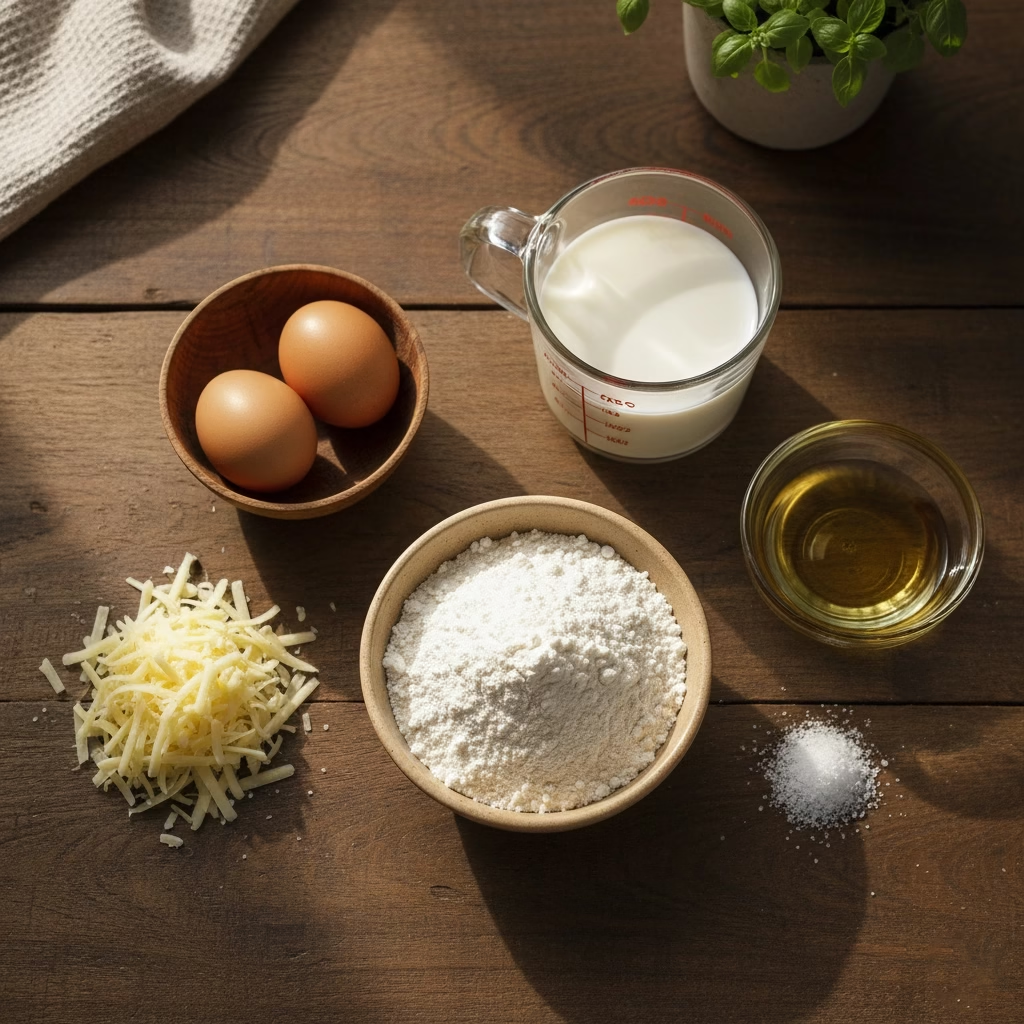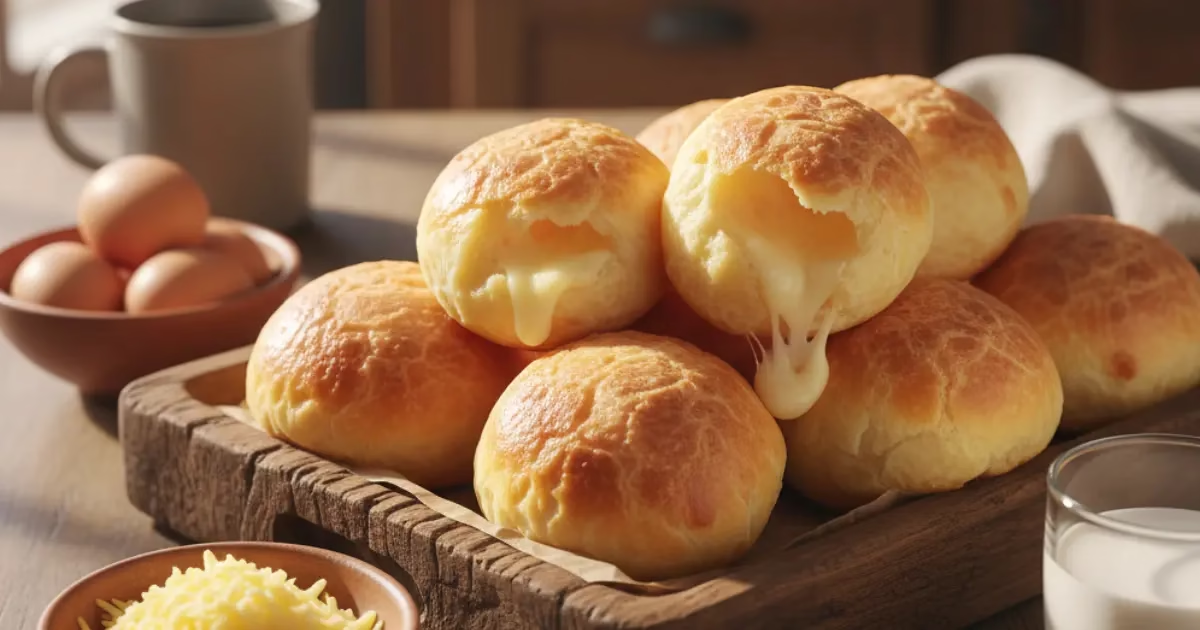Traditional pão de queijo recipes you can try at home.
Table of Contents
Introduction: A Bite of Comfort From Brazil
Have you ever bitten into something so simple, yet so satisfying, that it instantly made you smile? That’s exactly what happens when you taste pão de queijo—the beloved Brazilian cheese bread. Imagine pulling a tray out of the oven, the air filling with the smell of melted cheese and warm dough, and then enjoying a soft, chewy bite that’s golden on the outside and tender inside.
This little roll has been a staple in Brazil for centuries. It’s more than bread—it’s a cultural hug, a treat you’ll find on breakfast tables, in cafés, and during family gatherings. The best part? You don’t need to fly to São Paulo or Rio to enjoy it. With a few simple ingredients and some easy-to-follow steps, you can recreate traditional pão de queijo recipes at home and bring a piece of Brazil right to your kitchen.
What is Pão de Queijo? (Brazilian Cheese Bread Explained)
If you’re new to it, pão de queijo literally translates to “cheese bread” in Portuguese. But it’s not your typical bread. It’s chewy, cheesy, and naturally gluten-free, thanks to its star ingredient: tapioca flour.
In Brazil, pão de queijo has been cherished since the 18th century, when farmers first combined cassava starch with local cheeses to create these addictive bites. Today, it’s enjoyed everywhere—from street markets to high-end restaurants. Brazilians often eat it warm with a cup of strong coffee, but you can enjoy it anytime you crave a quick snack or want to impress guests with something unique.
Essential Ingredients for Authentic Pão de Queijo
Before you dive into baking, you need to understand what makes these little breads special. Each ingredient plays a specific role, and using the right ones ensures the perfect texture and flavor.
The Role of Tapioca Flour
Unlike wheat flour, tapioca flour (also called cassava starch) is naturally gluten-free and gives pão de queijo its signature chewy, elastic texture. If you swap it with regular flour, you’ll lose that bite. Both sweet tapioca flour and sour tapioca flour can be used, but each offers a slightly different flavor and texture.
The Best Cheese for Pão de Queijo
Traditionally, Brazilians use Queijo Minas, a mild and slightly salty cheese. Outside Brazil, it can be hard to find, so many home cooks substitute with Parmesan, mozzarella, or even cheddar. You can experiment with a mix—Parmesan for sharpness, mozzarella for stretchiness, and cheddar for richness.
Supporting Ingredients

- Eggs: Add structure and keep the dough together.
- Milk: Provides moisture and richness.
- Vegetable oil: Adds softness to the dough.
- Salt: Balances the cheesy flavor.
Here’s a simple ingredient table for a traditional recipe:
| Ingredient | Quantity | Notes |
| Tapioca flour | 2 cups | Sweet or sour variety |
| Grated cheese | 1 cup | Parmesan, mozzarella, or Minas |
| Milk | ½ cup | Whole milk for best results |
| Vegetable oil | ¼ cup | Neutral-flavored oil |
| Eggs | 2 large | Room temperature |
| Salt | 1 tsp | Adjust based on cheese used |
Traditional Pão de Queijo Recipe Step by Step
Now that you have the ingredients, it’s time to bake. Follow these steps closely for authentic results:
Preparation Instructions
- Preheat your oven to 375°F (190°C).
- In a small pot, heat milk and oil until just boiling.
- Pour the hot liquid over the tapioca flour in a large bowl and stir. The mixture will look sticky and crumbly—that’s normal.
- Let it cool slightly, then add the eggs one at a time, mixing well after each addition.
- Stir in the grated cheese until evenly combined.
- Shape the dough into small balls (about the size of a golf ball).
- Place them on a baking sheet lined with parchment paper.
- Bake for 15–20 minutes, or until golden and puffed.
Tips for Perfect Results
- Don’t overmix the dough—it should be soft and slightly sticky.
- For consistency, you can use a mini muffin tin.
- If you want fresh pão de queijo any time, freeze the shaped dough balls and bake straight from the freezer. Just add a few extra minutes.
Variations of Pão de Queijo Recipes You Can Try at Home
Once you’ve mastered the traditional method, it’s fun to get creative.
Classic vs. Modern Twists
- Traditional: Made with Minas cheese for authentic flavor.
- Parmesan & Mozzarella: A sharper taste with extra gooey texture.
- Garlic & Herb: Mix fresh garlic or dried herbs into the dough for added flavor.
Healthier Alternatives
- Low-Fat Cheese: Use reduced-fat versions to cut calories.
- Dairy-Free: Substitute plant-based milk and vegan cheese. The texture will differ slightly, but it’s still delicious.
Serving Ideas & Pairings
One of the best things about pão de queijo is its versatility.
When to Enjoy Pão de Queijo
- Breakfast: Pair with coffee or tea.
- Afternoon Snack: A quick bite to keep you going.
- Parties & Gatherings: Serve as appetizers.
Perfect Pairings
- Brazilian black coffee (strong and bold).
- Hot chocolate for a cozy winter treat.
- Fresh juices like orange or passionfruit.
Storage & Make-Ahead Tips
If you’re baking ahead of time, here’s how to keep them fresh:
- Freeze the dough: Shape the balls, place on a tray, freeze, then transfer to a bag. Bake when needed.
- Reheat baked pão de queijo: Pop them back in the oven at 300°F (150°C) for 5–7 minutes.
- Shelf life: They’re best fresh but can last up to 2–3 days at room temperature.
FAQ – Traditional Pão de Queijo Recipes You Can Try at Home
Can I make pão de queijo without tapioca flour?
Not really. Tapioca flour is what gives it that unique chewiness. You can try cornstarch or potato starch, but the texture won’t be the same.
What cheese works best in pão de queijo recipes?
Parmesan and mozzarella are the easiest to find, but if you want authentic Brazilian flavor, use Queijo Minas.
Are pão de queijo recipes gluten-free?
Yes! Since they’re made with tapioca flour, they’re naturally gluten-free.
Can I freeze pão de queijo dough?
Absolutely. Shape the dough, freeze it, and bake later. You don’t even need to thaw them.
How long does pão de queijo stay fresh?
They’re best eaten warm from the oven but can stay fresh for 2–3 days.
Conclusion: Bring Brazil to Your Kitchen
Now you know everything you need to make pão de queijo recipes at home—from authentic traditional versions to fun variations. These little cheese breads are more than just a snack; they’re a taste of Brazilian culture, a bite-sized piece of joy that brings people together.
So the next time you’re craving something warm, cheesy, and comforting, don’t just grab store-bought bread. Instead, roll up your sleeves, heat up your oven, and bake your own pão de queijo.
Call to Action: Try this recipe today and share your results with family or friends. Once they taste it, they’ll be asking you for more. And if you want to explore more Brazilian recipes, bookmark this page—you’ll never run out of delicious ideas!
There are no reviews yet. Be the first one to write one.

